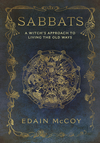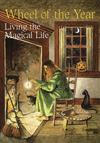The Faeries of Yule

When the Yule log is smoldering in the fireplace, warming the house with its golden glow, casting dancing shadows on a sparkling Yule tree with stacks of gifts wrapped in green, red, and gold, the scene immediately brings to mind faeries.
What, you ask? Faeries? It's probably been six months since your sabbat celebrations contained thoughts of the fey. They were Midsummers gift to the earth and those of us who worship its changes throughout the year. Do not be so certain the fey are not close by now just as they are throughout the rest of the wheel of the year. Like people, faeries appear in many different forms and have many different jobs. They do not all hibernate in winter, waiting for a sun-filled Beltane to bring them out of hiding and back to their jobs. Faeries not only show themselves in winter, but many are part of the mainstream's cultural consciousness. They are often very old deities who have been personified as the essence of winter and of the sun's rebirth.
The most pervasive faery of Yule is, of course, Santa Claus, the elderly, plump, red-garbed, holly-wearing symbol of twenty-first century conspicuous consumption. In Clement Moore's 1822 poem, "A Visit From Saint Nicholas" (now known as "The Night Before Christmas"), he describes Santa as a "right jolly old elf… with a big, round belly, that shook when he laughed like a bowl full of jelly." Moore also gave his creation magical powers. Santa comes and goes through the chimney, long regarded in Europe as the magical portal between our world and the unseen world, and he managed it with only a finger to his nose and a nod. Hummm… Those gestures bring a bit of the magic of Samantha Stephens and I Dream of Jeannie to the modern mind.
Moore's intent was not to create a character to personify the Yule season, but to put to paper something to amuse his children. Still, we must wonder how much old Pagan folklore Mr. Moore was aware he was drawing upon in creating Saint Nicolas, or Santa Claus. Moore was a professor at the General Theological Seminary of New York and wrote several scholarly books, including a Hebrew-English lexicon. Moore was probably more aware of the origins of Santa Claus than many of his contemporaries and even most of today's secular celebrants.
Santa has his roots in the European wheel of the year as the Holly King and his twin, the Oak King. This character with two faces was once worshiped as the God of the wheel of the year. In old Europe he had many names and faces. What unifies his place in folklore is his representation of the two solar cycles of the year.
It is no accident that our Santa Claus wears a sprig of holly on his elven-style hat, or that he appears as a kindly old gentleman. Six months ago, at the summer solstice, this King went to battle with himself. The Oak King, the spirit of the waxing solar year, must die so that the Holly King, the spirit of the waning solar year, can manifest. At Yule, also known as the winter solstice, the Holly King (in the guise of Santa Claus) shows himself as an old man with gray hair and a long gray beard. Clearly his time on earth is nearing an end with the solar year. In popular culture this passing of the torch of rulership to a younger guardian is portrayed on December 31 as the elderly old year steps aside to let baby new year reign over us on January 1.
As it has been with many Pagan deities, their functions and form were adopted and altered to fit the needs of the Roman conquerors of Europe. Today Santa is an elf, the spirit of the season of giving and feasting, and a symbol of the ending year.
The other popular faery of Yule is Jack Frost, also known as Old Man Winter. This is the personification of sacrificial God of autumn, who awaits his rebirth in spring, along with the winter world over which he presides. The folklore of northwestern Europe and Russia took this God of winter and made him into the capricious Lord of Winter's worst aspects. Stinging ice, blinding blizzards, dangerous temperatures, and those blasted frozen water pipes in your house are all under the spells of Jack Frost.
Jack Frost rules over his snow faeries, who carve each delicate snowflake from falling ice. He directs the frost faeries to blanket windows and cleared fields. He commands the element of air to blow hard and wide across farm fields and city streets. As Old Man Winter he is once again presented to us as the old year which he will eventually give up to the guardianship young God of spring.
Every February 4 from 1813 until the outbreak of World War I in 1914, Londoners celebrated the good things given to them by this winter faery. Dubbed The Festival of King Frost, this minor holiday was a welcome break between the celebrations of Christmas and the bounty of May Day. The day including ice-skating, sledding, sleigh riding, and the building snow people. It ended with a retreat into the warmth of the homes of family or friends for food and drink.
The most common faery "job" is, of course, the guardianship of nature. This is easy for us to visualize in spring when we watch from warm windows the new green buds begin to sprout on trees and the first flowers of spring begin to push through a warming earth. The fey are seen as both assisting in this transformation and embodying it. The Dryads, the spirits of trees who dwell within their boughs, are perfect examples of this symbiotic connection. They are both serving the tree and being an essential part of the tree.
Protection is needed for any creature when it is vulnerable, and winter is when most living things are their weakest. Deciduous trees grow brittle in the cold. The animals they house leave or sleep. The humans who come to break off branches for firewood, or who want to cut down the tree, meet no resistance. Like many of the fey we are hunkered down someplace warm to wait for spring.
The Dryads remain in their trees even when that tree appears to have no life. The same respect must be shown to trees in the winter as we give them in the summer. We must always ask before we cut branches, and, in keeping with Pagan tradition, we must offer the Dryads something special for their sacrifice. In winter there can be no greater gift than the offering of grains and other feed for the animals that forage the woods all winter to find food.
Making a commitment to feed non-migrating birds is a perfect way to show respect for the spirits of nature. Keep in mind that this is a commitment to nature you can keep until the ground thaws and insects appear so that birds can find their own food. Birds will settle within five miles of a reliable food source and will be counting on you to fill their feeder everyday. By the way, the expression "eat like a bird" is so misinterpreted. Birds eat many times their weight each day in feed.
Cornell University maintains a web page called Project Feeder Watch, designed for Americans and Canadians who want to identify their winter birds and be able to offer them the right food. This can be found at http://www.birds.cornell.edu/pfw/AboutBirdsandFeeding/abtbirds_index.html.
Yule marks the beginning of a delicate phase of the wheel of the year for living things, one during which nature and her creatures need the greatest protection. Underneath the frozen ground the faerie spirits of grasses, flowers, and bushes also await the spring. In the forests wild animals give birth to the next generation, and in numerous cocoons the vulnerable caterpillar awaits its rebirth in spring as a butterfly. The folklore linking faeries with butterflies is worldwide. In some cultures the butterfly is a spirit of nature or a faery, in others the wintertime faeries protect the cocoon until the butterfly emerges. Folktales of faeries riding on the backs of butterflies are well known and are a cause for pensiveness when they are seen among summer flowers.
Never forget that the spirit of nature does not die. Like us, the faery folk may seek warmer quarters as Yuletide arrives, but they are still present, protecting and caring for the living mother earth and her children.

About Edain McCoy
Related Products



is subject to certain Terms and Conditions